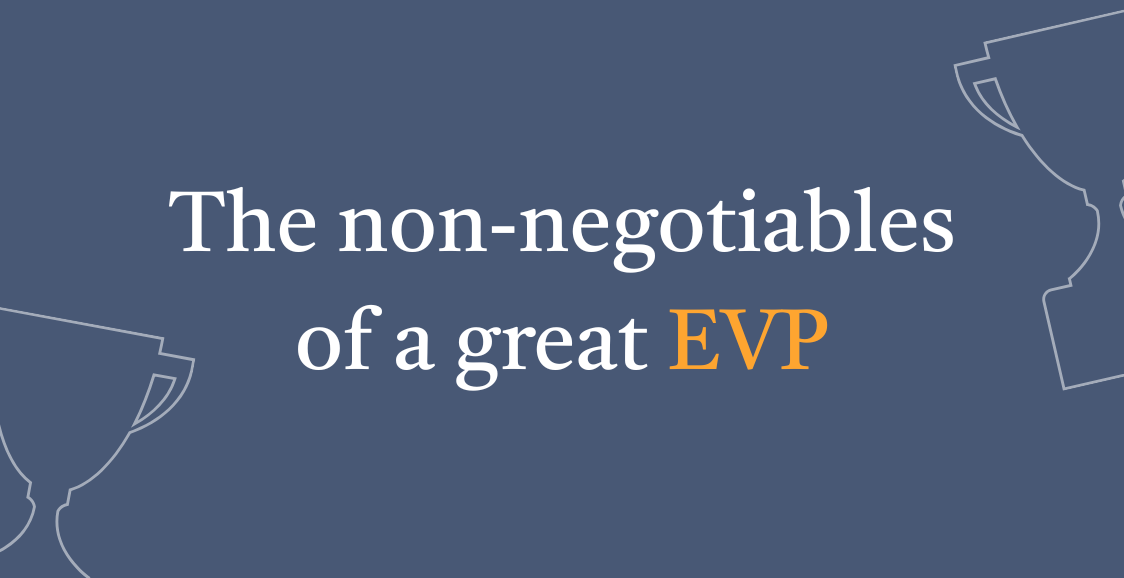Your Employee Value Proposition (EVP) is more than just a branding exercise—it’s a promise to candidates and employees alike. A compelling EVP helps attract top talent, foster engagement, and boost employee retention. To be competitive, your EVP needs to evolve alongside candidate expectations, organisationalorganizational goals, and market trends; whilst accurately representing who you are and delivering on your promises.
Treating your EVP as a living, breathing strategy that’s regularly refreshed will enable you to capture candidates’ attention and satisfy your workforce. So, how can you ensure your EVP remains relevant and effective? Here are key considerations for shaping a compelling EVP.
1. What makes your organisationorganization unique?
A strong EVP needs to go above and beyond standard benefits. It should clearly convey why your organisationorganization is the best place to work and how you stand out from competitors. To achieve this, you must identify your differentiators—what makes your company unique in the talent market? Is it your culture, career growth opportunities, leadership, or innovation?
Being authentic is crucial; your EVP should reflect reality. Candidates and employees will quickly see through an EVP that doesn’t align with their experiences. Moreover, aligning your EVP with your mission and values reinforces your organisationorganization’s purpose and long-term vision, fostering stronger connections with employees and candidates who share your values.
Ask yourself:
- Can you articulate what truly differentiates your organisationorganization from competitors?
- Does your EVP reflect your company’s values and long-term goals?
- Have you gathered feedback from employees to ensure your EVP is authentic?
2. How is your EVP embedded at each stage of the talent journey?
It’s easy to craft an EVP that sounds great on paper, but does it hold up throughout the employee lifecycle? Ensuring your EVP is more than just a recruitment tool is essential for long-term engagement. Your EVP should go beyond attraction; it must be delivered consistently throughout the employee experience.
Regularly assessing gaps in EVP implementation can help identify discrepancies between hiring messages and actual workplace experiences. Using feedback mechanisms like employee surveys and engagement assessments can help keep you in the loop. Additionally, leveraging exit interviews can provide valuable insights into where EVP expectations and reality diverged, allowing organisationsorganizations to address these gaps and strengthen retention efforts.
Ask yourself:
- Do employees feel that your EVP matches their actual experience?
- Are there discrepancies between what is promised in recruitment and what is delivered?
- Are employees getting more from your EVP at different stages of their career or is it consistent throughout the employee journey?
3. Does your EVP appeal to a multigenerational audience?
With five generations coexisting in today’s workforce, a one-size-fits-all EVP won’t work. Understanding the unique motivators of different generational cohorts is key. OrganisationsOrganizations must acknowledge shifting workplace dynamics, as Baby Boomers, Gen X, Millennials, and Gen Z each have distinct career drivers, from stability to purpose to flexibility. Understanding what attracts talent within different age groups and career stages will ensure you’re meeting expectations across the board.
Younger workers may prioritiseprioritize career development and work-life balance, while older employees may value job security and leadership opportunities. Tailoring benefits and experiences accordingly, such as offering flexible work arrangements, personalisedpersonalized career growth paths, and benefits that resonate with different demographics, can ensure inclusivity. Showcasing real stories of how your organisationorganization meets the needs of diverse employees through internal mobility, mentorship, and inclusive policies further strengthens your EVP.
Ask yourself:
- Have you considered the needs of different generations when shaping your EVP?
- Do your benefits and policies appeal to a diverse workforce?
- Are you collecting feedback from employees of different age groups or career stages to understand what matters to them?
4. Does your onboarding reinforce your culture and EVP?
Onboarding is your first opportunity to prove that your EVP is more than just words. A strong onboarding process sets the stage for employee success and long-term engagement. To make onboarding engaging and immersive, go beyond paperwork by incorporating interactive elements like mentorship programs, team meetups, and hands-on training.
Delivering on your EVP promises early in the onboarding experience reinforces to employees that they made the right choice. Additionally, fostering connection by encouraging new hires to engage with leadership, peers, and employee resource groups builds a sense of belonging from day one.
Ask yourself:
- Does your onboarding process reinforce the promises made in your EVP?
- Are new hires engaged and supported from day one?
- What touchpoints exist to help new employees feel connected to your culture?
5. Are you tracking the effectiveness of your EVP?
An EVP is only as strong as its impact. To ensure it’s driving the right results, organisationsorganizations need a data-driven approach. Measuring alignment between your EVP and the actual employee experience requires regularly collecting and analysing feedback. Using multiple data points, such as candidate experience surveys, onboarding feedback, employee engagement metrics, and retention rates, provides a comprehensive view of EVP effectiveness. Setting clear KPIs tailored to your organisationorganization—whether that’s improving offer acceptance rates, boosting engagement scores, or reducing turnover—helps track success and make necessary adjustments.
Ask yourself:
- Do you have measurable KPIs to track the success of your EVP?
- Are you gathering and acting on employee feedback?
- How frequently do you review and refine your EVP?
A strong EVP will be dynamic, data-driven, and deeply embedded in the employee experience. By focusing on authenticity, delivering on promises throughout the talent journey, ensuring inclusivity across generations, and continuously measuring effectiveness, organisationsorganizations can create an EVP that truly resonates. Regular evaluation and adaptation are key to staying competitive in the talent market. By prioritisingprioritizing these considerations, HR and TA leaders can craft an EVP that not only attracts talent but also fosters long-term engagement and retention.
Learn more about how to build an attractive EVP and what really matters to jobseekers in our candidate experience report here.





